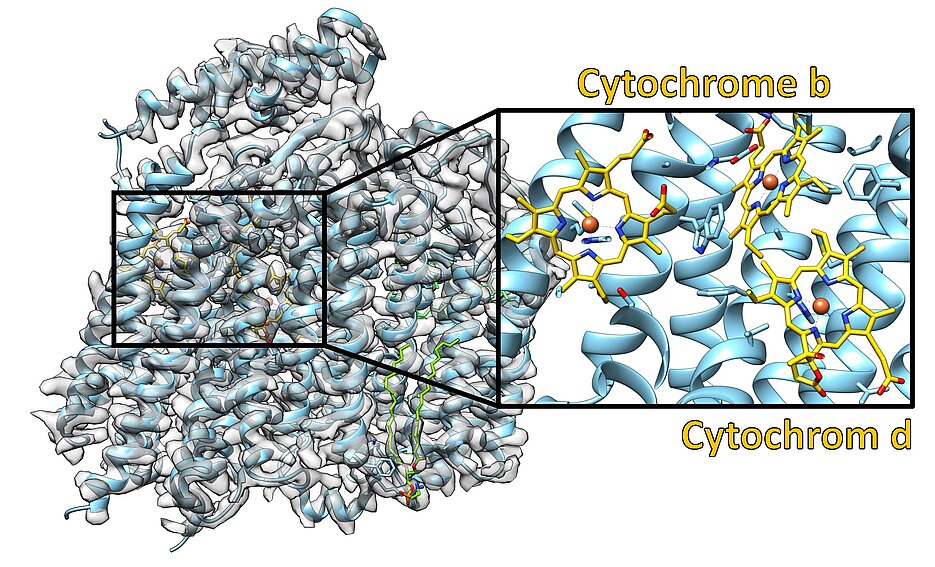Architecture of a bacterial power plant decrypted
11/13/2019Scientists from the University of Würzburg and the University of Freiburg succeeded in determining the complex molecular structure of the bacterial enzyme cytochrome bd oxidase. Since humans do not have this type of oxidase, this enzyme could be an interesting target for novel antibiotics.

Both humans and many other creatures need oxygen for survival. In the conversion of nutrients into energy, the oxygen is converted to water, for which the enzyme oxidase is responsible. It represents the last step of the so-called respiratory chain.
Energy production with the help of the enzyme oxidase
While humans have only one type of these oxidases, the bacterial model organism Escherichia coli (E. coli) has three alternative enzymes available. In order to better understand why E. coli and other bacteria need multiple oxidases, Prof. Bettina Böttcher from the Rudolf Virchow Center in collaboration with Prof. Thorsten Friedrich (University of Freiburg) have determined the molecular structure of the cytochrome bd oxidase from E. coli. This type of oxidase is found only in bacteria and microbial archaea.
Bacteria have other types of oxidase
The eponymous cytochromes, two of type b and one of type d, are the key iron-containing groups that enable the function of oxidase. At the cytochrome d, the oxygen is bound and converted to water. The structure determination revealed that the architecture of cytochrome bd oxidase from E. coli is very similar to the structure of another bacterium, Geobacillus thermodenitrificans. "However, to our great surprise, we discovered that a cytochrome b and cytochrome d have changed positions and thus the site of oxygen conversion within the enzyme," reports Prof. Thorsten Friedrich.
The cause of this change could be that the cytochrome bd oxidase might fulfill a second function: in addition to the energy production, it can serve to protect against oxidative stress and stress by nitroxides. Particularly pathogenic bacterial strains show a high activity of cytochrome bd oxidase. Since humans do not have this type of oxidase, these results might furthermore provide important indications on the development of new antimicrobials that target the cytochrome bd oxidase of pathogens such as Mycobacteria.
Important for this success was the new high-performance electron microscope, which has been operated since 2018 under the direction of Prof. Böttcher at the Rudolf Virchow Center. "Cytochrome bd oxidase was a challenging sample for cryo-electron microscopy because it is one of the smallest membrane proteins whose structure has been determined with this technique," explains Prof. Bettina Böttcher.
Special features of this technique are extremely low temperatures down to minus 180 degrees Celsius and a resolution that moves in the order of atoms. It makes it possible to study biological molecules and complexes in solution that have been previously snap frozen and to reconstruct their three-dimensional structure. With a voltage of 300,000 volts, the microscope accelerates the electrons with which it "scans" the samples.
The study was published in November 2019 in the journal Nature Communications.
Publication
Alexander Theßeling#, Tim Rasmussen#, Sabrina Burschel, Daniel Wohlwend, Jan Kägi, Rolf Müller, Bettina Böttcher* and Thorsten Friedrich*: Homologous bd oxidases share the same architecture but differ in mechanism. Nature Communications, Nov 2019, DOI:10.1038/s41467-019-13122-4
People
Prof. Bettina Böttcher is Professor of Biochemistry and since 2016 head of a research group at the Chair of Biochemistry and at the Rudolf Virchow Center for Experimental Biomedicine at the Julius-Maximilians-University (JMU) Würzburg.
Prof. Thorsten Friedrich has been Professor of Biochemistry at the Faculty of Chemistry and Pharmacy at the Albert-Ludwigs-University Freiburg since 2001 and since 2016 has been in charge of the DFG-funded Research Training Group 2202 "Transport over and in membranes".
Contact
Dr. Tim Rasmussen (Böttcher Group, Rudolf Virchow Center)
Tel. 0931 31 89659, tim.rasmussen@uni-wuerzburg.de
Prof. Bettina Böttcher (Rudolf Virchow Center, Julius-Maximilians-University Würzburg)
Tel. 0931 31 84193, bettina.boettcher@uni-wuerzburg.de
Prof. Thorsten Friedrich (University Freiburg)
Tel. 0761 203 6060, friedrich@bio.chemie.uni-freiburg.de
Dr. Daniela Diefenbacher (Press Office, Rudolf Virchow Center )
Tel. 0931 31 88631, daniela.diefenbacher@uni-wuerzburg.de


